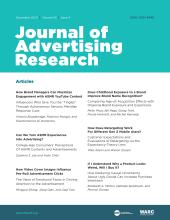Abstract
Autonomous sensory meridian response (ASMR)—a feeling of well-being combined with a tingling sensation in the scalp and down the back of the neck—has become increasingly popular on social media, leading researchers to investigate its potential for advertising. Although extant research has shed light on the characteristics of ASMR cues and of their receivers, it has tended to treat said cues as homogeneous and focused on outcomes that are largely outside the digital realm. Against these shortcomings, this article merges techniques from digital research and automated text analysis to explore how ASMR sources (i.e., branded, sponsored, and nonsponsored) shape users’ digital engagement with ASMR content on YouTube. In doing so, this study contributes to the burgeoning sensory marketing literature and provides actionable insights to marketers who want to enter the ASMR domain.
- ASMR
- autonomous sensory meridian response
- influencer marketing
- digital engagement
- video advertisements
- social media
- branded, sponsored and nonsponsored content
- Received February 15, 2023.
- Received (in revised form) August 8, 2023.
- Accepted August 9, 2023.
- Copyright © 2023 ARF. All rights reserved.
ARF MEMBERS
If you are a member of the Advertising Research Foundation, you can access the content by logging in here
Log In
Pay Per Article - You may access this article (from the computer you are currently using) for 30 days for US$20.00
Regain Access - You can regain access to a recent Pay per Article purchase if your access period has not yet expired.





